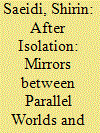| Srl | Item |
| 1 |
ID:
167419


|
|
|
|
|
| Summary/Abstract |
In this article, we theoretically conceptualise the renegotiation of participatory action and activism through the formation of intellectual space that is self-reflective and upheld by what we metaphorically describe as mirrors between parallel worlds. Rethinking what activism is and how an individual relates to their social group is dependent on different levels of self-reflection, self-criticism and competing scales of insertion of other people’s struggles into one’s own political vision in an effort to intellectually rectify the local tensions that emerge in a post-revolutionary context where people are disconnected from global-level activism. A significant aspect of this analysis is our interlocutors’ imaginative capacity to draw from other people’s experiences through cultural and visual artefacts and integrate them into their own life history with the intention to address national or group-specific dilemmas. While some have drawn attention to the importance of noting how spaces for activism are remade in the post-revolutionary context due to such sentiments as disappointment, we instead examine the formation of conceptual spaces of activism within the context of isolation in contemporary Iran. Empirically, we bring together a political analysis of the novel Bevatan by Reza AmirKhani, and interviews conducted with English literature students in Shiraz.
|
|
|
|
|
|
|
|
|
|
|
|
|
|
|
|
| 2 |
ID:
125166


|
|
|
|
|
| Publication |
2013.
|
| Summary/Abstract |
Turning on the logic of the spectacle, U.S.-based campaigns on North Korean human rights, in calling for intervention, have wielded two images aimed at outing North Korea's "hidden truths"? the image of the starving child circa the 1990s and the contemporary satellite image of what appear to be labor camps. Focusing on the use of online virtual geo-imagery programs like Google Earth in the human rights mapping of North Korea, this essay situates post-9/11 "liberation technology" within the framework of the unending Korean War, a war whose failed "liberation" of Korea from the global forces of communism haunts North Korean human rights critique today. By examining mid-century bomber photographs and contemporary human rights satellite images of North Korea, this essay inquires into the homology between technologies of militarized intelligence and war, on the one hand, and technologies of human rights that aim to expose North Korea, on the other. Both modes of apperception, this essay argues, strive to delegitimize and destroy rather than faithfully represent the enemy.
|
|
|
|
|
|
|
|
|
|
|
|
|
|
|
|